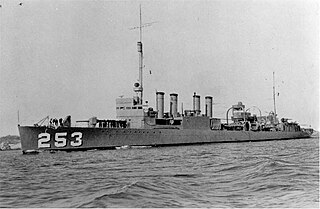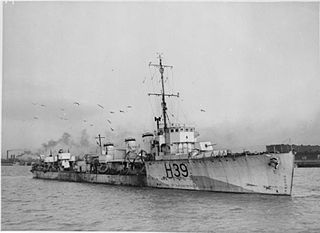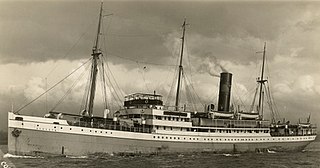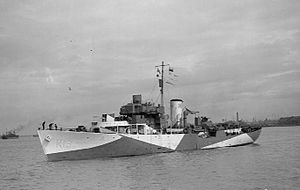
The Flower-class corvette was a British class of 294 corvettes used during World War II by the Allied navies particularly as anti-submarine convoy escorts in the Battle of the Atlantic. Royal Navy ships of this class were named after flowers.
HMS Audacity was a British escort carrier of the Second World War and the first of her kind to serve in the Royal Navy. She was originally the German merchant ship Hannover, which the British captured in the West Indies in March 1940 and renamed Sinbad, then Empire Audacity. She was converted and commissioned as HMS Empire Audacity, then as HMS Audacity. She was torpedoed and sunk by a German U-boat in late 1941.

The first USS McCalla (DD-253) was a Clemson-class destroyer in the United States Navy. She transferred to the Royal Navy as HMS Stanley (I73) during World War II.

HMS Scarborough was a Hastings-class sloop of the Royal Navy launched in 1930. She served in the Second World War, especially as a convoy escort in the North Atlantic.

The Mediterranean U-boat Campaign lasted from about 21 September 1941 to 19 September 1944 during the Second World War. Malta was an active British base strategically located near supply routes from Europe to North Africa. Axis supply convoys across the Mediterranean Sea suffered severe losses, which in turn threatened the fighting ability of the Axis armies in North Africa. The Allies were able to keep their North African armies supplied. The Kriegsmarine tried to isolate Malta but later it concentrated its U-boat operations on disrupting Allied landing operations in southern Europe.
HMS Marigold was a Flower-class corvette of the Royal Navy. She was launched on 4 September 1940 and was sunk by an Italian air-dropped torpedo on 9 December 1942.

HG 76 was an Allied convoy of the HG series, during the Second World War. It was notable for the destruction of five German U-boats.

HMS Fowey was a Shoreham-class sloop of the Royal Navy. She served during the Second World War.
36th Escort Group was a British formation of the Royal Navy which saw action during the Second World War, principally in the Battle of the Atlantic. The group operated mainly on the Gibraltar and South Atlantic convoy routes and was involved in several convoy battles, including Convoy HG 76, one of the first Allied victories in the Atlantic campaign.

An Escort Group consisted of several small warships organized and trained to operate together protecting trade convoys. Escort groups were a World War II tactical innovation in anti-submarine warfare by the Royal Navy to combat the threat of the Kriegsmarine's "wolfpack" tactics. Early escort groups often contained destroyers, sloops, naval trawlers and, later, corvettes of differing specifications lacking the ability to maneuver together as a flotilla of similar warships, but rigorously trained in anti-submarine tactics to use teamwork emphasizing the unique sensors, weapons, speed, and turning radius of each ship. The development of these 'escort groups' proved an effective means of defending shipping convoys through the Battle of the Atlantic.

HMS Stork (L81) was a Bittern-class sloop of the Royal Navy. She was active during the Second World War, serving in convoy escort groups, and was a successful anti-submarine warfare vessel, being credited with the destruction of four U-boats.
OG 82 was an Allied convoy of the OG series during World War II. The action involving this convoy resulted in the destruction of a U-boat, and also had consequences for German U-boat strategy.

HMS Blankney was a Hunt-class destroyer of the Royal Navy and was the first and so far only warship to bear the Name. She was laid down on 17 May 1940 at John Brown & Company, Clydebank, Scotland, launched on 19 December 1940 and commissioned on 11 April 1941.

HMS Wishart (D67) was a Modified W-class destroyer of the British Royal Navy that saw service in World War II. She spent most of her wartime career based at Gibraltar, engaged in convoy defence, but also served in various naval and military operations in the Mediterranean Sea.
Convoy HG 73 was a trade convoy of merchant ships during the Second World War. It was the 73rd of the numbered HG convoys Homeward bound to the British Isles from Gibraltar. The convoy departed Gibraltar on 17 September 1941 and was found on 18 September and was attacked over the next ten days. Nine ships were sunk from the convoy before the submarines exhausted their torpedo inventory on 28 September. Surviving ships reached Liverpool on 1 October.

SS Avoceta was a British steam passenger liner. She was built in Dundee in 1923 and was sunk by enemy action in the North Atlantic in 1941. She belonged to Yeoward Line, which carried passengers and fruit between Liverpool, Lisbon, Madeira and the Canary Islands.
Convoy HG 53 was the 53rd of the numbered series of World War II HG convoys of Homeward bound merchant ships from Gibraltar to Liverpool. Convoy HG 53 lost nine ships during a coordinated attack in February 1941. HG 53 was one of the few Atlantic convoys to have ships sunk by submarines, by aircraft, and by surface ships.

HMS Deptford was a Grimsby-class sloop of the British Royal Navy. Built at Chatham Dockyard in the 1930s, Deptford was launched in 1935 and commissioned later that year. The ship saw early service on the Persian Gulf station, but the outbreak of the Second World War saw Deptford serving as a convoy escort in the North Atlantic and the Mediterranean, sinking a German U-boat in 1941. She survived the war and was scrapped in 1948.
HG 70 was an Allied convoy of the HG series during World War II. It was attacked by a pack of ten U-boats, without success. All U-boats were beaten off, and they sank no ships of the convoy. Two ships were lost to aircraft; 23 ships arrived safely.
World War II was the first war where naval aviation took a major part in the hostilities. Aircraft carriers were used from the start of the war in Europe looking for German merchant raiders and escorting convoys. Offensive operations began with the Norwegian campaign where British carriers supported the fighting on land.












